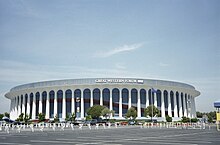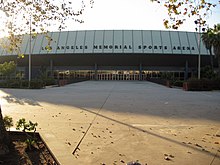
The 1932 Summer Olympics were an international multi-sport event held from July 30 to August 14, 1932, in Los Angeles, California, United States. The Games were held during the worldwide Great Depression, with some nations not traveling to Los Angeles as a result; 37 countries competed, compared to the 46 at the 1928 Games in Amsterdam, and even then-U.S. President Herbert Hoover did not attend the Games. The organizing committee did not report the financial details of the Games, although contemporary newspapers stated that the Games had made a profit of US$1 million.

The Los Angeles Memorial Coliseum is a multi-purpose stadium in the Exposition Park neighborhood of Los Angeles, California, United States. Conceived as a hallmark of civic pride, the Coliseum was commissioned in 1921 as a memorial to Los Angeles veterans of World War I. Completed in 1923, it will become the first stadium to have hosted the Summer Olympics three times when it hosts the 2028 Summer Olympics, previously hosting in 1932 and 1984. It was designated a National Historic Landmark on July 27, 1984, a day before the opening ceremony of the 1984 Summer Olympics.

The Rose Bowl is an outdoor athletic stadium located in Pasadena, California. Opened in October 1922, the stadium is recognized as a National Historic Landmark and a California Historic Civil Engineering landmark. At a modern capacity of an all-seated configuration at 96,400, the Rose Bowl is the 16th-largest stadium in the world, the 11th-largest stadium in the United States, and the 10th-largest NCAA stadium. The stadium is 10 miles (16 km) northeast of downtown Los Angeles.

Weingart Stadium is a 22,355-capacity multi-purpose stadium located at East Los Angeles College, in Monterey Park, California. It was built in 1951 at a cost of $3.1 million, and following renovations in 1984 it was renamed after philanthropist Ben Weingart.
The National Football League (NFL) has had a long and complicated history in Los Angeles, the second-largest media market in the United States. Los Angeles became the first city on the West Coast to host an NFL team when the Cleveland Rams moved to Los Angeles in 1946; they played at the Los Angeles Memorial Coliseum from 1946 until 1979. In 1960, a charter American Football League franchise, the Los Angeles Chargers, began playing in the Coliseum. The Chargers moved to San Diego after their inaugural season, where they eventually joined the NFL as part of the AFL-NFL merger. The Rams moved to suburban Anaheim, California, in 1980. A surprising move in 1982 brought the Oakland Raiders to the Coliseum to become Los Angeles Raiders.

The San Diego Chargers were a professional American football team in the National Football League (NFL). The Chargers played in San Diego from 1961 until the end of the 2016 season, before relocating back to Los Angeles, where the franchise had played its inaugural 1960 season. The team is now known as the Los Angeles Chargers.

The 1983 season was the Los Angeles Raiders' 14th season in the National Football League (NFL), their 24th season overall, and their second season in Los Angeles. The team began by attempting to improve on their 8–1 record from 1982 and went on to win the Super Bowl for the third time in franchise history. Prior to the Los Angeles Rams victory in Super Bowl LVI, the 1983 Raiders were the only NFL team to win the Super Bowl while based in Los Angeles. They became the 2nd team in NFL history to win 3 Super Bowls, the first being the Steelers.

The Greater Los Angeles area is home to many professional and collegiate sports teams and has hosted many national and international sporting events. The metropolitan area has twelve major league professional teams: the Los Angeles Lakers, the Los Angeles Dodgers, the Los Angeles Rams, the Los Angeles Clippers, the Los Angeles Angels, LA Galaxy, Los Angeles FC, the Los Angeles Kings, the Los Angeles Chargers, Los Angeles Sparks, the Anaheim Ducks, the Los Angeles Knight Riders of the MLC Major League Cricket, their Minor League Cricket affiliate SoCal Lashings, and Angel City FC of the National Women's Soccer League. The Los Angeles metropolitan area is home to nine universities whose teams compete in various NCAA Division I level sports, most notably the UCLA Bruins and USC Trojans. Between them, these Los Angeles area sports teams have won a combined 105 championship titles. Los Angeles area colleges have produced upwards of 200 national championship teams.

The 1985 Tennessee Volunteers football team represented the University of Tennessee in the 1985 NCAA Division I-A football season. Playing as a member of the Southeastern Conference (SEC), the team was led by head coach Johnny Majors, in his ninth year, and played their home games at Neyland Stadium in Knoxville, Tennessee. They finished the season with a record of nine wins, one loss and two ties, as SEC champions and with a victory over Miami in the 1986 Sugar Bowl. The Volunteers offense scored 325 points while the defense allowed 140 points. At season's end, the Volunteers ranked fourth in both the AP Poll and the Coaches' Poll.

For the 1968 Summer Olympics, a total of twenty-five sports venues were used. Most of the venues were constructed after Mexico City was awarded the 1968 Games. Mexican efforts in determining wind measurement led to sixteen world records in athletics at the University Olympic Stadium. All four of the football venues used for these games would also be used for both of the occurrences that Mexico hosted the FIFA World Cup, in 1970 and 1986.

For the 1976 Summer Olympics, a total of twenty-seven sports venues were used. Several venues used had been in existence before Montreal made its first Olympic bid in the late 1930s. By the 1950s, Montreal's bid for the Olympics shifted from Winter to Summer before it was finally awarded the 1976 Summer Games in 1970. Strikes in 1974 and 1975 affected construction of the Montreal Olympic Park, most notably the stadium, pool, and velodrome, to the point where the FINA President threatened to not have the diving, swimming, and water polo events take place there for the games in early 1976 though all three venues were completed as best as possible prior to the 1976 Games. 27 swimming world records were set as a result. The oldest stadium, Molson Stadium at McGill University, would be converted into artificial turf for the field hockey tournaments while the sailing program in Kingston, Ontario, would be held in freshwater, both for the first time in Summer Olympic history. Indoor track cycling took place at the Olympics for the first time at the velodrome. Once the Olympics finished, the Montreal Expos and Montreal Alouettes moved into Olympic Stadium, staying until 2004 and 1997, respectively. The Montreal Canadiens remained at the Montreal Forum until they moved to the Molson Centre in March 1996. In 1992, the velodrome was converted into an indoor zoo now known as the Montreal Biodôme. Île-Notre Dame hosted a canoe sprint world championships and two rowing world championships since the 1976 Games, but the area north of the basin on the island has been host to the Formula One Canadian Grand Prix on an almost annual basis since 1978.
A total of twenty-nine sports venues were used for the 1996 Summer Olympics.

The Los Angeles Raiders were a professional American football team that played in Los Angeles from 1982 to 1994 before relocating back to Oakland, California, where the team played from its inaugural 1960 season to the 1981 season and then again from 1995 to 2019.














